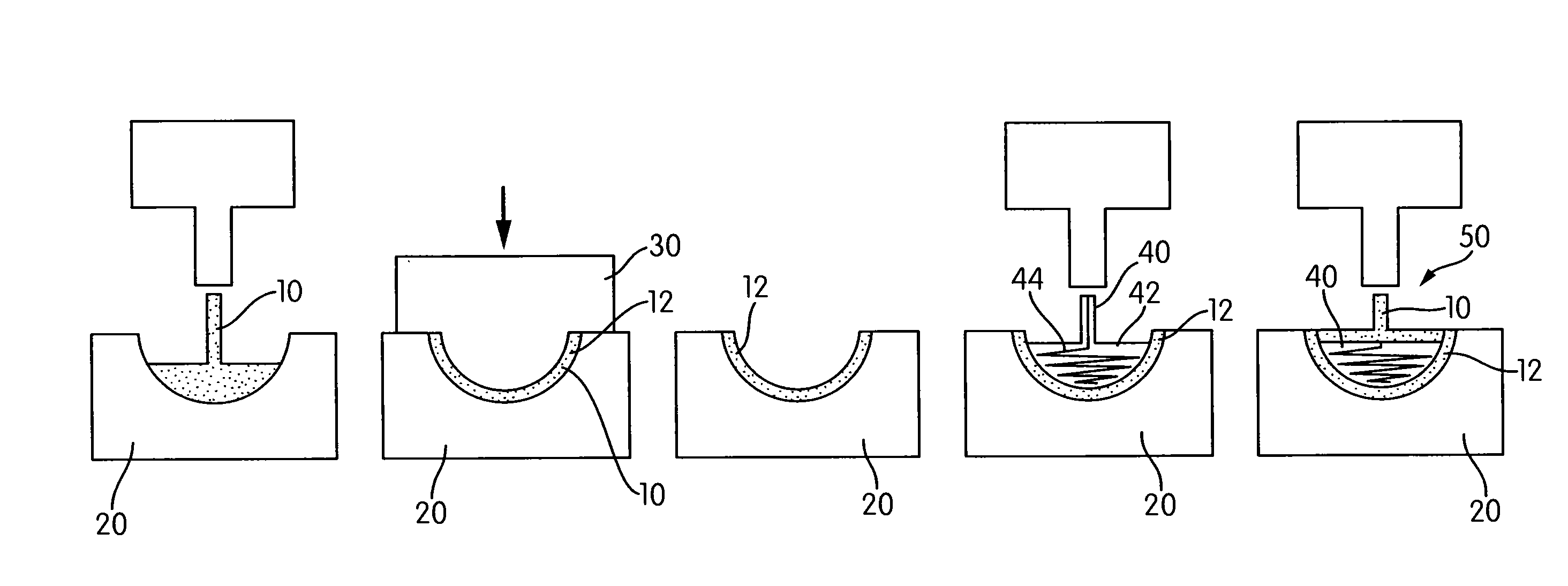Confectionery product and method of making
a technology of confectionery products and methods, applied in confectionery, food science, sweetmeats, etc., can solve the problems of increasing equipment footprint, limiting the amount of filling, and limiting the filling of hard candies to about 25%, so as to enhance the eating experience
- Summary
- Abstract
- Description
- Claims
- Application Information
AI Technical Summary
Benefits of technology
Problems solved by technology
Method used
Image
Examples
example 1
[0048]A confectionery in accordance with an exemplary embodiment was formed as a bite size piece (20 mm inner diameter hemispherical shape and weight 7.5 g+ / −0.5 g) formed in a Teflon coated aluminum mold with ejection pin.
[0049]The piece included a stamped shell of cooked sugar mass, formed in the manner described herein. The cooked sugar mass was a milk-containing high boil (caramel hard candy) of 3.4% to 3.9% by weight final moisture. The shell had an engineered shell thickness of 1.7 mm.
[0050]The shell was filled with a laminate-like co-deposit of the same milk-containing high boil co-deposited with white compound using a depositor obtained from Winkler and Dünnebier Süβwarenmaschinen GmbH. The volume ratio of high boil candy mass to white compound in the co-deposit was 2:3. Subsequent examination showed the co-deposit filling was observed as having formed with many layers to provide a munchable, “typical laminated” type texture.
[0051]Finally, a deposit of the same high boil was...
example 2
[0052]A confectionery in accordance with an exemplary embodiment was formed as a bite size piece in a Teflon coated aluminum mold with ejection pin. The bite size piece had a weight of 7.5 g+ / −0.5 g, and included a 2.6 g stamped shell of cooked sugar mass having a 20 mm inner diameter hemispherical shape, formed in the manner described herein.
[0053]The cooked sugar mass was a fruit flavored hard candy formed from sugar, water, glucose syrup, and sorbitol to a 3.4% by weight moisture content. The shell had an engineered shell thickness of 1.7 mm and was filled with a 3 g mono-deposit of a soft fruit chew composition.
[0054]Some of the shells were left open, while others were closed with a closure mass placed on the top of the filling to provide closure of the piece. The closure mass included a 2 g deposit of the same fruit flavored hard candy at 3.9% by weight moisture. The thickness of the final deposit was carefully controlled (via heat and vibration) to provide a minimum thickness ...
example 3
[0055]A confectionery in accordance with an exemplary embodiment was formed as a bite size piece in a polycarbonate chocolate mould. The mould included an embossed design which created an engraving on the top of the product. The bite size piece had a weight of 9.0 g+ / −0.2 g, and included a 2.0 g stamped shell of cooked sugar mass having a 30 mm diameter curved disk shape with a height of 8 mm, formed in the manner described herein.
[0056]The cooked sugar mass was a milk-containing high boil (caramel hard candy) of 3.6% by weight final moisture. The shell had an engineered shell thickness of 1.1 mm, and was filled with a 4 g co-deposit of comingled layers of the same caramel hard candy and a white compound paste.
[0057]Finally, a 3 g deposit of the same caramel hard candy at 3.5% by weight moisture was placed on the top of the filling to provide closure of the piece. The thickness of the final deposit was carefully controlled (via heat and vibration) to provide a minimum thickness that...
PUM
 Login to View More
Login to View More Abstract
Description
Claims
Application Information
 Login to View More
Login to View More - R&D
- Intellectual Property
- Life Sciences
- Materials
- Tech Scout
- Unparalleled Data Quality
- Higher Quality Content
- 60% Fewer Hallucinations
Browse by: Latest US Patents, China's latest patents, Technical Efficacy Thesaurus, Application Domain, Technology Topic, Popular Technical Reports.
© 2025 PatSnap. All rights reserved.Legal|Privacy policy|Modern Slavery Act Transparency Statement|Sitemap|About US| Contact US: help@patsnap.com


